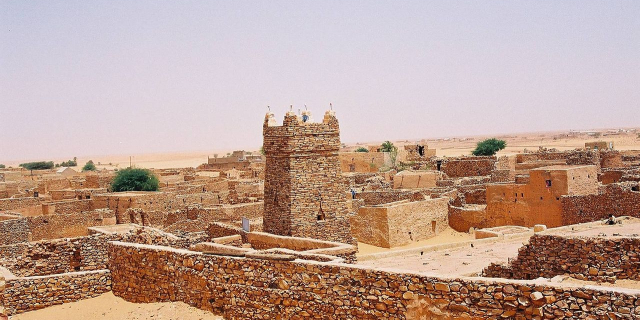Chinguetti () (Arabic: شنقيط, romanized: Šinqīṭ) is a ksar and a medieval trading center in northern Mauritania, located on the Adrar Plateau east of Atar. Chinguetti had a population of 4,800 as of 2013.
Founded in the 13th century as the center of several trans-Saharan trade routes, this small city continues to attract a handful of visitors who admire its spare architecture, scenery, and ancient libraries. The city is seriously threatened by the encroaching desert; high sand dunes mark the western boundary and several houses have been abandoned to the sand.
The town is split in two by a wadi. On one side, there is the old sector, and on the other the new one. The indigenous Saharan architecture of older sectors of the city features houses constructed of reddish dry-stone and mud-brick techniques, with flat roofs timbered from palm...Read more
Chinguetti () (Arabic: شنقيط, romanized: Šinqīṭ) is a ksar and a medieval trading center in northern Mauritania, located on the Adrar Plateau east of Atar. Chinguetti had a population of 4,800 as of 2013.
Founded in the 13th century as the center of several trans-Saharan trade routes, this small city continues to attract a handful of visitors who admire its spare architecture, scenery, and ancient libraries. The city is seriously threatened by the encroaching desert; high sand dunes mark the western boundary and several houses have been abandoned to the sand.
The town is split in two by a wadi. On one side, there is the old sector, and on the other the new one. The indigenous Saharan architecture of older sectors of the city features houses constructed of reddish dry-stone and mud-brick techniques, with flat roofs timbered from palms. Many of the older houses feature hand-hewn doors cut from massive ancient acacia trees, which have long disappeared from the surrounding area. Many homes include courtyards or patios that crowd along narrow streets leading to the central mosque.
Occupied for thousands of years, the Chinguetti region was once a broad savannah; rock paintings at Agrour Amogjar, in the nearby Amogjar Pass, feature images of giraffes, cows, and people in a green landscape. It is quite different from the sand dunes of the surrounding desert, which make up most of the region today.[1]
FoundingThe city was founded in AD 777. The name Chinguetti means "spring of horses" in the Azayr language, an extinct dialect of Soninke that was heavily mixed with Berber. The area, at that time far more green than today, was home to agricultural peoples ancestral to several sub-Saharan ethnic groups, including the Soninke.[2] : 15, 71
Center of TradeBy the 11th century, Chinguetti had become a trading center for a confederation of Berber tribes, known as the Sanhaja. They eventually melded with the Almoravids, represented by Abdallah ibn Yasin, who would eventually control an empire stretching from present-day Senegal to al-Andalus in modern-day Spain. The city's stark, unadorned architecture reflects the strict religious beliefs of the Almoravids, who spread the Malikite rite of Sunni Islam throughout the Western Maghreb.
After two centuries of decline, the city was effectively re-founded in the 13th century as a fortified trading-center for nomadic trans-Saharan caravans, and as a means of connecting the Mediterranean with Sub-Saharan Africa. Although the walls of the original fortification disappeared centuries ago, many of the buildings in the old section of the city date from this period.
World Heritage SiteIn 1996, UNESCO designated Chinguetti, along with the cities of Ouadane, Tichitt and Oualata, also in the dunes area, as a World Heritage Site.[3] Notable buildings in the town include The Friday Mosque of Chinguetti, an ancient structure of dry-stone construction, featuring a square minaret capped with five ostrich egg finials; the former French Foreign Legion fortress; and a tall watertower. The old quarter has five important manuscript libraries of scientific and Qur'anic texts, with many dating from the later Middle Ages. In recent years, the Mauritanian government, the U.S. Peace Corps, and various NGOs have attempted to position the city as a center for adventurous tourists. Visitors may "ski" down its sand dunes, visit the libraries, and appreciate the stark beauty of the Sahara.
The Friday Mosque is widely considered by Mauritanians to be the national symbol of the country.[1] The recently discovered offshore oilfield was named Chinguetti in its honor.






























Add new comment